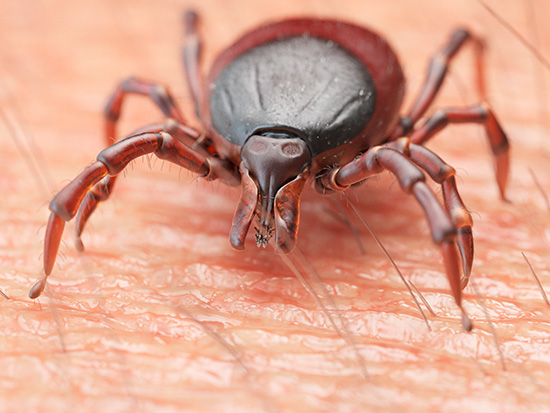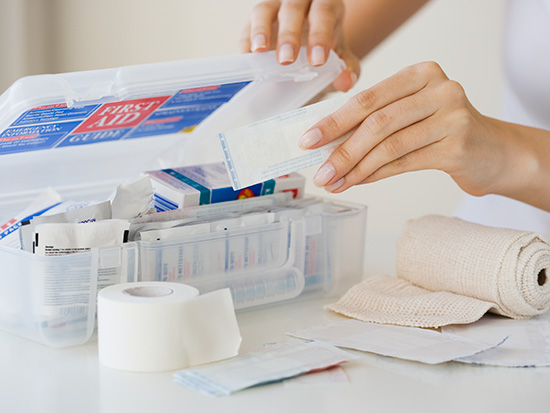 Warmer weather has folks venturing outdoors, and while the risk of running into a snake, bear or other menacing animal exists, much smaller critters are far more likely to be encountered in the great outdoors. In fact, a lot of bugs, such as ticks, mosquitos, wasps and other insects, can pack a powerful bite or sting.
Warmer weather has folks venturing outdoors, and while the risk of running into a snake, bear or other menacing animal exists, much smaller critters are far more likely to be encountered in the great outdoors. In fact, a lot of bugs, such as ticks, mosquitos, wasps and other insects, can pack a powerful bite or sting.
Keeping bugs at bay
Walter Schrading, M.D., professor of emergency medicine and director of the Office of Wilderness Medicine in the Heersink School of Medicine at the University of Alabama at Birmingham, recommends using an approved insect repellant while wearing long pants and long-sleeved shirts if outside in buggy areas. Products containing DEET are considered the most effective repellants, but picaridin and oil of lemon eucalyptus-based products are effective, comparable to lower concentrations of DEET.
Schrading offers these tips on the use of products containing DEET:
- Read and follow all directions and precautions on the product label.
- Store DEET out of reach of children.
- To apply to face, first spray product onto hands, then rub onto face.
- Use only when outdoors, and wash skin with soap and water after coming indoors.
- Check the label for the concentration of DEET. A product with a 25 percent concentration of DEET provides about six to eight hours of protection.
- Use just enough repellent to cover exposed skin and/or clothing. Avoid over-application of the product.
- DEET may be used on adults, children and infants older than 2 months of age. Protect infants from mosquito bites by using a carrier draped with mosquito netting with an elastic edge for a tight fit.
An option for use on clothing or tents is Permethrin. It is an insecticide, not a repellant, so it should not be applied to the skin.
Tackling ticks
The likelihood of getting Lyme disease, a common tick-borne illness from a local tick bite, is low in the Southeast, according to Schrading. Ticks in Alabama are known to carry the bacterium that causes Rocky Mountain spotted fever, characterized by a flulike illness, followed by a red, raised rash on the wrists or ankles. The best way to remove a tick, he says, is to grasp the tick with tweezers as close as possible to the skin’s surface and pull straight up in an easy motion. Wash the area with rubbing alcohol or soap and water. Do a full body check after spending time in a potential tick environment. Ticks that have been embedded less than 24 hours are unlikely to spread disease.
Don’t get stung
“One of the biggest outdoor risks is bee or wasp stings, especially for those with severe allergic reactions,” said Marie-Carmelle Elie, M.D., chair of the UAB Department of Emergency Medicine. “A severe allergic reaction, known as anaphylaxis, can be fatal.”
She recommends that those with a history of an allergic reaction carry an epinephrine auto-injector, commonly known as an EpiPen, when camping or hiking. If anyone in the group has ever reacted badly to previous stings, an EpiPen is key. EpiPens require a prescription from a physician and can be purchased at a drugstore.
Oh, for goodness snakes
 Elie says the best way to avoid snakebite is to watch carefully for the presence of snakes while in the woods or near rivers or creeks, and wear long pants and boots. She says the most important safety gear you can carry is a cellphone and your car keys.
Elie says the best way to avoid snakebite is to watch carefully for the presence of snakes while in the woods or near rivers or creeks, and wear long pants and boots. She says the most important safety gear you can carry is a cellphone and your car keys.
“Get to an emergency department as quickly as you safely can, and that can often be accomplished by calling 911,” Elie said. “Snap a picture of the snake with the cellphone if possible, but leave the snake behind. The last thing we need in a crowded emergency room is a snake, dead or alive.”
She says emergency physicians do not need to see the snake. Some bites are dry with no venom injected or are from a nonvenomous snake. Bites from venomous snakes such as copperheads, rattlesnakes and cottonmouths that do inject venom will produce symptoms. The victim will have pain, swelling and discoloration at the bite site, often with fang marks. Bites where no venom is injected will show no symptoms over a period of several hours of observation. Snakebites are not usually fatal; those at increased risk are the very young, the very old and those with underlying medical conditions.
Be prepared
 Schrading says a good first-aid kit is a must for anyone planning on spending time outdoors. Ready-made kits are available at outdoor stores, or they can be assembled from materials on hand. Include assorted bandages and basic medicines such as Tylenol, Benadryl and aspirin. Albuterol will help those with group members who have asthma or COPD. Include a 1 percent hydrocortisone anti-itch cream, foldable splints, alcohol wipes and cleaning agents.
Schrading says a good first-aid kit is a must for anyone planning on spending time outdoors. Ready-made kits are available at outdoor stores, or they can be assembled from materials on hand. Include assorted bandages and basic medicines such as Tylenol, Benadryl and aspirin. Albuterol will help those with group members who have asthma or COPD. Include a 1 percent hydrocortisone anti-itch cream, foldable splints, alcohol wipes and cleaning agents.
He also recommends planning before heading to the woods or mountains. Research the destination, and know what to expect. Be aware of the strengths and weaknesses of your group. Who has allergies? Who knows CPR? Are there any special needs to be considered?
Proper clothing, rain gear, plenty of water and emergency food supplies will help keep an unexpected event from turning an outdoor vacation into a hospital visit.
“Common sense and a little thought before you venture out will help make your outdoor adventure one to remember fondly,” Schrading said.
